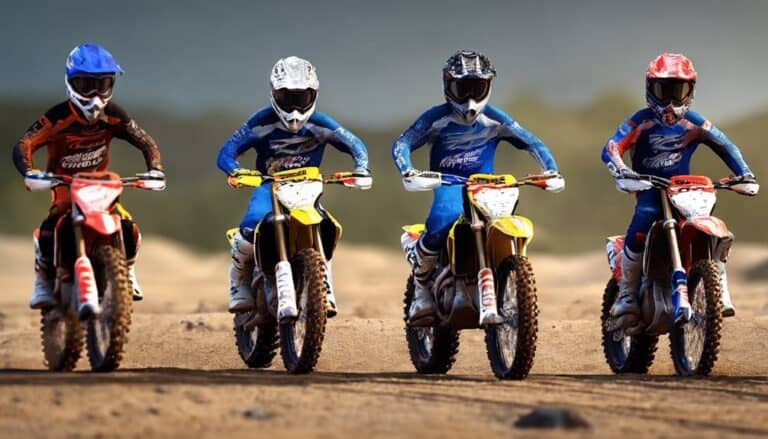You might not be aware that mastering the differences in riding techniques between motocross and other types of dirt bikes can greatly impact your performance on various terrains.
From body positioning to braking techniques, each style demands specific skills to navigate effectively. Understanding these nuances could be the key to unveiling your full potential as a rider and elevating your dirt biking experience.
Key Takeaways
- Motocross emphasizes aggressive body positioning and precise techniques for speed and competition.
- Trail riding values adaptability, endurance, and technical skills on natural terrains.
- Motocross demands high-speed maneuvers and jumping techniques for competitive advantage.
- Trail riding focuses on varying speeds and endurance rather than speed and aggressive competition.
Motocross Bike Body Positioning
When riding a motocross bike, maintaining the correct body positioning is essential for maximizing control and maneuverability on the track.
Motocross riders adopt an aggressive stance, leaning their bodies forward to distribute weight effectively. Keeping the elbows up not only guarantees stability but also helps absorb impacts during jumps and landings, allowing for a smoother ride.
By shifting their weight towards the front of the bike, riders can enhance traction and improve steering responsiveness, especially when negotiating corners and rough terrain. Unlike other dirt biking disciplines, motocross riders actively engage their legs to absorb bumps and assist in maneuvering through challenging sections of the track, showcasing the dynamic nature of their body positioning technique.
This strategic approach to body positioning is vital for maintaining balance, control, and agility, empowering riders to tackle obstacles and tight turns with precision and confidence. Mastering these techniques empowers riders to push their limits and dominate the track with finesse.
Cornering Techniques in Motocross
In mastering cornering techniques in motocross, riders harness aggressive leaning and strategic body positioning to navigate turns at high speeds with precision and control. When tackling corners in motocross, here are some key points to keep in mind:
- Early Turn Initiation: Start your turn early, leaning the bike into the corner while keeping your body upright for balance and stability.
- Utilize Suspension and Throttle Control: Use the bike's suspension and throttle control to maintain speed through the turn, ensuring you avoid washouts and maintain traction.
- Inside Leg Pivot: Use your inside leg as a pivot point, sticking it out for balance and pushing against the bike for sharper turns.
- Dynamic Body Positioning: Emphasize maintaining momentum and speed by choosing the right line and adjusting your body positioning dynamically throughout the corner.
Jumping Techniques in Motocross
Mastering jumping techniques in motocross demands a combination of skillful maneuvering and precise timing to achieve supreme height and distance. In motocross, riders utilize techniques like preload and strategic body positioning to optimize jump height and distance.
Proper throttle control plays a critical role in maintaining balance and control while airborne. Landing techniques are vital, involving the absorption of impact with knees and elbows to reduce jolts and guarantee stability upon landing.
To maintain speed and gain a competitive advantage, motocross riders often practice scrubbing jumps, a technique that minimizes airtime. Achieving the desired jump height and distance requires impeccable timing and coordination, ensuring smooth takeoffs and landings for efficient race performance.
Braking Differences in Motocross
Utilizing aggressive braking techniques is essential in motocross for controlling speed and maneuvering tight turns on the track efficiently. In motocross, proper braking involves a combination of techniques and skills to make sure you have the necessary control over your bike.
Here are some key points to think about:
- Motocross riders rely on both the front and rear brakes simultaneously to achieve quick stops and maintain control over the bike.
- Feathering the brakes is a common practice in motocross, allowing you to modulate braking power for best traction and cornering.
- Shifting your body weight to the rear during braking helps prevent the front wheel from washing out on loose or muddy terrain.
- Mastering braking techniques is important for maintaining momentum, controlling speed, and executing fast and precise maneuvers on the track.
Comparing Motocross and Trail Riding Styles
Comparing the riding styles of motocross and trail riding reveals distinct approaches to terrain exploration and skill emphasis. In motocross, riders tackle groomed tracks with aggressive, high-speed maneuvers, focusing on maintaining speed through jumps and sharp turns. Body positioning is vital for precise control during these dynamic actions.
On the other hand, trail riding involves exploring natural terrains at varying speeds, prioritizing endurance and technical skills to overcome obstacles like rocks and roots. Trail riders must adapt their body positioning and speed to handle the unpredictable terrain effectively.
Motocross demands quick reflexes and aggressive techniques suited for competitive racing, pushing riders to their limits in the quest for speed and victory. Conversely, trail riding values endurance and adaptability in challenging environments, where riders must demonstrate resilience and skill in conquering diverse obstacles.
While motocross emphasizes speed and competition, trail riding focuses on mastering difficult terrains through adaptability and endurance, highlighting the unique demands each riding style presents.
Conclusion
To sum up, mastering the riding techniques for motocross bikes versus other dirt bikes is like traversing through two different terrains. Just as a skilled surfer adjusts their stance on calm waves versus rough surf, riders must adapt their body positioning, cornering, jumping, and braking techniques to conquer the challenges of motocross.
It's like switching gears between two distinct landscapes, each requiring a unique set of skills and strategies to ride with confidence and control.

